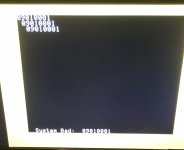pb3623
Well-known member
So in between working on our A/UX imaging project, trying to work through some Q950 issues and (on the side) my new SGI O2... I have a IIgs that I got in trade about six months ago that’s pretty much sat the whole time.
Main issue is this: with the RAM expansion card installed (yes, it’s pointed in the correct direction), there’s a high-pitch, almost CRT whine from the PSU and the screen is filled with inverse @@@@@@@@@@@@ (like it does briefly on power-up before POST). Without the card, it boots so in my mind, it’s the card or the (original) caps on the logic board.
I remember it starting up when I first got it, enough to see it worked (connected to composite).
There’s only apparently 256KB on the board so I’d love to see if the RAM card can be salvaged! Thanks!
- It’s a ROM 01 unit.
- MicroDrive CF card w/ 512 MB CF
- ByteBoosters 4 MB RAM expansion card
- serial card
- I clipped the PRAM battery and got the alligator clip battery pack to replace it
- I bought an upgraded PSU from ReActiveMicro and that got installed last week
- I bought the Spanish HD15-to-SCART cable, a SCART-to-HDMI upscaler and an HDMI-DVI cable that doesn’t appear to pass the signal
Main issue is this: with the RAM expansion card installed (yes, it’s pointed in the correct direction), there’s a high-pitch, almost CRT whine from the PSU and the screen is filled with inverse @@@@@@@@@@@@ (like it does briefly on power-up before POST). Without the card, it boots so in my mind, it’s the card or the (original) caps on the logic board.
I remember it starting up when I first got it, enough to see it worked (connected to composite).
There’s only apparently 256KB on the board so I’d love to see if the RAM card can be salvaged! Thanks!

